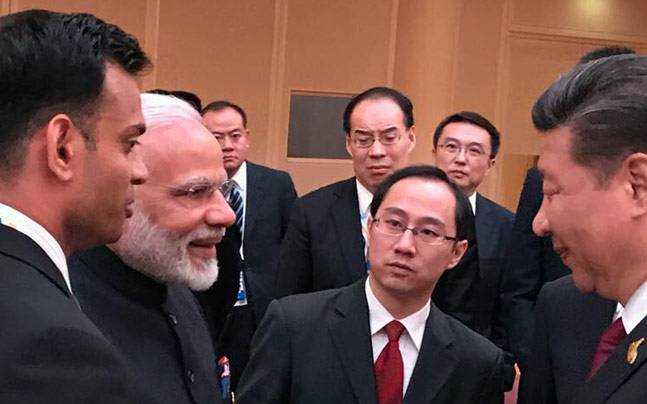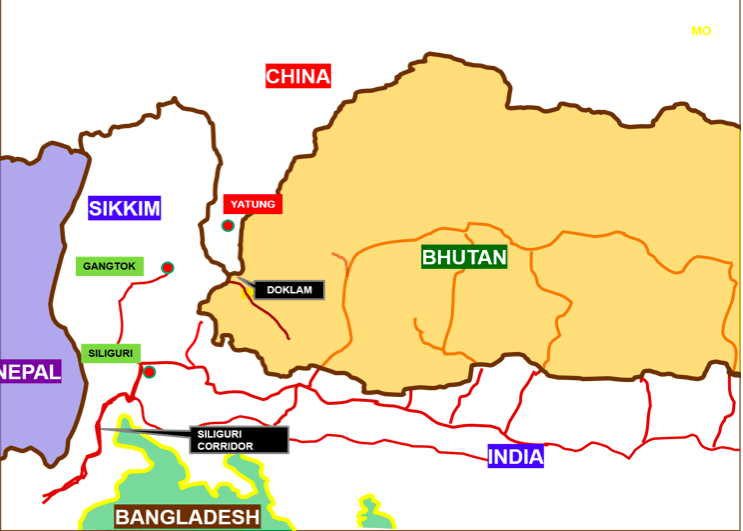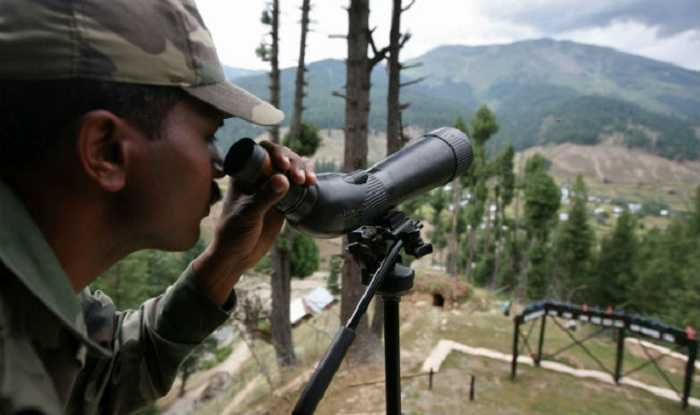News Grille
Rajan Grover. Editorial.VIII.XXVII.XVII
DOKLAM DUMPLINGS!
 By Rajan Grover
By Rajan Grover
Post-Edit
TROOPS BEGIN PULLBACK on 28/Aug.

Having tasted its new found economic wealth and military might, China is now emerging as a revisionist and expansionist power. It has been on the roll since a decade or so and is behaving uncouth defying all the major powers and established international norms. With the West and US influence on decline, particularly after the change of guard in White House and its subsequent revocation of TPP (Trans-pacific economic partnership), China seems to be in a hurry to become the global cop. It is running territorial and maritime disputes with almost all of its neighbours. The Doklam standoff with India and Bhutan must also be seen in the continuity of its efforts to change the world order and expand its boundaries in accordance with its own prerogative.

The Doklam plateau, which lies at the tri junction of India, China and Bhutan, has been an accepted disputed area between Bhutan and China since 1980’s. China started road construction in this area - a unilateral attempt to change the status quo in mid june 2017. Bhutan objected to it and called for India’s help as per India – Bhutan Friendship Treaty of 2007. It was also in the national interest of India to stop the construction of this road by China, which it naturally did, by sending its troops to Doklam. Since then, the soldiers from both the countries are involved in the deadlock and are in eye ball to eye ball position.
While India’s posture on this issue is mature and calm but resolute on the ground, China has gone berserk and has responded by its full blown strategy of “three warfare” consisting of manipulating public opinion through media, psychological warfare and legal warfare. True to the words of Sun Tzu that all warfare is based on deception, there have been continuous vitriolic attacks on India from the official Chinese media, the foreign ministry and the defence ministry. The triad has included belligerence, insults and threats of military action to teach India a ‘more bitter lesson than 1962’. There are reports of stone pelting between the troops of both sides at Pangong Lake in Ladakh. China is using every possible tactic including the media blitzkrieg and holding military exercises in Tibet to intimidate India to force its unilateral withdrawal from Doklam, without giving assurance to give up its plan to construct the road till consensus is reached. Since the construction of this road will present a real danger to ‘Siliguri Corridor’ and the neighbouring oil refineries of Assam, Indian army has not moved back even an inch.
Having followed the Chinese propaganda to influence the discourse of events (video of seven sins of India) and their use of psychological warfare as a “supreme art of war to subdue the enemy without fighting” - here are the rebuttals to their bluff propagated by their media, followed by corresponding Indian POV (Point of View):
1. China says, Doklam is a Chinese territory and Bhutan has agreed to it also. Not true. It is a disputed territory between China and Bhutan. After all, China has held 24 border talks with Bhutan for settlement including Doklam in recent years: Remember the demarche to China by Bhutan on June 29, 2017 asking Chinese troops to withdraw and restore the status quo.
2. ‘If there is any issue, it is between China and Bhutan. India has no role to interfere between us’, says China. A reminder to China; as per a 2012 agreement, between Indian and China, this issue of the tri – junction boundary needs trilateral consultations.
3. China believes the 1890 Treaty between China and British India clearly establishes the control of China over Doklam. Even Prime Minister Nehru had accepted in a letter dated September 26, 1956 to the Chinese authorities. “There is no dispute on the China Sikkim border.” China ignores the phrase ‘Bhutan Frontiers’ mentioned in the 1890 Treaty which means that boundary lines were not clearly demarcated between Bhutan and Tibet (now China) in 1890.
Also the reference to the said portion of letter is purely selective and must be seen in totality of context, in which Nehru further says “… Chinese maps show sizeable areas of Bhutan on part of Tibet. The rectification of errors in Chinese maps regarding the boundary of Bhutan with Tibet is, therefore, a matter which has to be discussed along with boundary of India with the Tiber region of China in the same sector.” This exactly was supposed to be discussed between India, china and Bhutan as per agreement of 2012 reached by special representatives of India and China, agreeing to maintain status quo till the final result.
4. China had already informed India a month ago about its decision to construct the road in Doklam. Instead of having consultations as per the agreement, China chose to just inform India about its “decision”.
5. It has threatened that if India can enter Doklam at the request of Bhutan, China can also enter Kashmir at the request of Pakistan. Through building CPEC, China has already entered POK, a disputed territory between India and Pakistan. It also has huge financial stakes in projects relating to power generation in POK.
6. China has repeatedly refused to declare Pakistan’s sponsored Masood Azhar, a global terrorist, despite a near unanimity in the United Nations, whereas, it shamelessly continues to describe the unarmed Tibetan spiritual leader Dalai Lama as a terrorist.
7. According to China, The McMohan line defining India- China boundary has no legal base. China was not a signatory to it and Tibet had no right to sign the treaty as it was not an independent nation. But surprisingly, the same McMohan Line defining the boundary with Myanmar is acceptable to China. A clear case of picking the parts of history by China which suits its interest.
8. China vigorously opposes the entry of India’s membership in the NSG (Nuclear Suppliers Group) on the technical ground that India is not a signatory to NPT. It insists upon simultaneous membership of Pakistan, another non signatory to NPT whose nuclear proliferation record is well known, along with India in this group. Infact, Pakistan has been a prime instrument of China to contain India.

9. While China expects India to be sensitive towards its ‘core issues’ of Tibet and Taiwan, it had mischievously started to issue “stapled visas” to the residents from J&K and Arunachal Pradesh. It also didn’t care about India’s concerns of sovereignty in PoK for its project CPEC. It calls Arunachal Pradesh as “South Tibet” and has recently given Chinese names to some of its places without realizing that India can also call Tibet as “North Arunachal Pradesh”.
China is biting more than it can chew, as if creating two rogue nuclear states of Pakistan and North Korea as its proxies was not enough, it is ridiculously indulging in subjective cartographic interpretations, citing its ancient dynastic rulers to arbitrarily fix its maritime boundaries with neighbours. It outrightly rejected the UN arbitration in favour of Philippines in South China Sea. In this modern age of Nation States, if ancient history is a guide to settle boundary issues, India can also claim its rights over the Man Sarovar Lake in Tibet, the home of Lord Shiva, where the Indian Pilgrims have been visiting for centuries. Also, by this logic, the Great Wall of China must be the natural boundary of China because, historically it was built to save the Chinese territory from the outside invaders!
With the Doklam standoff entering in the third month, there is still no solution in sight. An all-out war between the two regional giants is not a serious option, but it has a potential to spread to political and other socio-economic domains. China has started playing ‘water card’ by delaying the data of Himalayan rivers to India, causing devastating floods in Assam. It also plans to use the artificial lake at Pareechu above Himachal Pradesh as a ‘water bomb’. India, on her part has imposed anti-dumping duty to some Chinese items. It has initiated review of IT import from China. Though China’s exposure with Indian market is miniscule (According to 2016 figures, out of total trade of $ 3685 Billion of China, trade with India stands at $ 71.48 billion), this review could turn out to be Achilles’ heel for China if other countries follow suit as well. India has invited all Heads of States of ASEAN as special guests on its Republic Day in 2018, and it can also think about supplying BrahMos and other military hardware to Vietnam, the arch rival of China.
Clearly, both the countries have many cards to play against each other, but reaching a point of no return is not in the interest of either side. Much water has flown through the Ganga and the Brahmputra since 1962. Some innovative and smart diplomacy is needed by both countries to defuse the situation. Till then, India needs to hold the nerve, hold the tongue and hold the ground.
_______________________________
Disclaimer: The opinions/views expressed within this article are the personal opinions of the author. fnbworld/News for Soul is not responsible for the accuracy, completeness, suitability, or validity of any information in this article. All information is provided on an as-is basis. The information, facts or opinions appearing in the article do not reflect the views of fnbworld and fnbworld does not assume any responsibility or liability for the same. [The online tabloid believes in open source; feel free to use any material with due attribution (Mandatory) to the author and webzine with a hyperlink. Thank You].